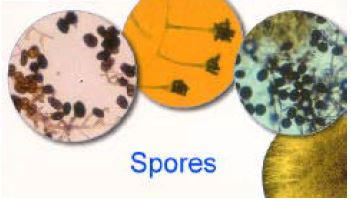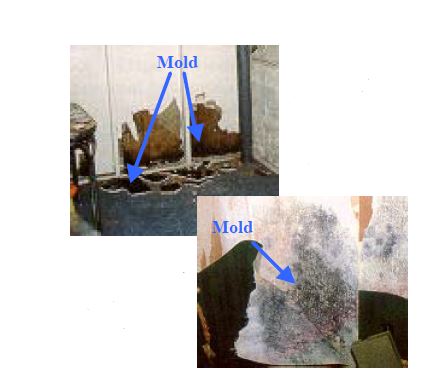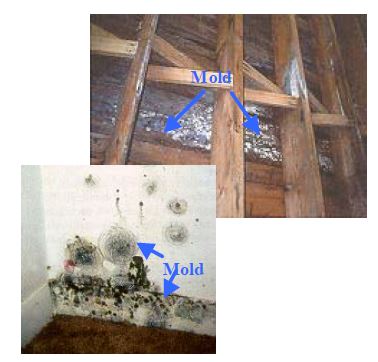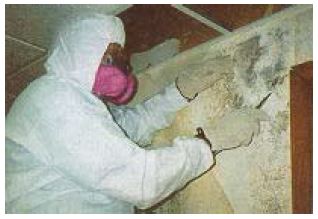Introduction
Molds belong to the group of organisms called fungi and as such, are neither animals nor plants. There are more than 1.5 million fungi worldwide, not all of which are molds, but molds are found in every environment. When moisture and oxygen are present, they grow on organic substances by digesting plant and animal matter for energy. Anything of organic origin may be subject to attack. Outdoors, molds play a key role in the breakdown of leaves, wood and other organic debris.
Molds reproduce through microscopic spores (Fig. 1). Spores are moved in water, through the air by breezes, even by a passing person or animal. Several fungi actively discharge spores when environmental conditions are right. Consequently, mold spores are found in indoor and outdoor air. Virtually every breath we take contains mold spores.
Figure 1. Spores produced on fungi (molds) growing in laboratory petri dishes.

When spores land on damp areas, they begin growing as they digest the organic matter around them. They stain wood structures, produce, home and garden furnishings—any product made from plants or animals.
Most molds are harmless to humans. However, some produce mycotoxins that affect people and animals. Individuals can suffer allergic reactions or infections from inhaling, ingesting, or touching mold or mold spores. An individual’s sensitivity to a particular mycotoxin depends on his or her innate resistance to it, how much toxin is present (its concentration), how long a person is exposed to the mold producing it, and whether or not it is ingested, inhaled or touched. All these factors must be considered when associating molds with health concerns.
One strain of mold, stachybotrys, has received considerable media attention. It is believed to be the cause of several health problems for people who live or work in structures with water or moisture problems. However, the presence of mold does not always mean harmful mycotoxins are present. Even so, removing existing molds and preventing any new molds from growing can avoid potential health concerns.
Molds require several specific conditions to grow. Controlling any of the following conditions will control their development:
In Cooperation with the Nevada Department of Agriculture
Moisture is necessary in sufficient amounts for mold to develop. In poorly ventilated spaces, organic substances absorb moisture. Moisture contents from 25% to 75% are considered optimal for mold development. Poor ventilation causes the relative humidity (RH) of the air to increase, which encourages mold to grow. Keeping an area well ventilated, especially in Nevada, reduces the RH of the air, keeps the area dry and prevents mold growth.
Food (energy) is required for molds to flourish. Molds readily digest proteins and starches from organic substances such as bread, cheese, and animal products (leather, wallpaper paste, etc.) used in home construction.
Temperature is as crucial to mold development as moisture or food. Like other organisms, molds have a temperature range in which they develop. Temperatures between 50 ºF and 90 ºF are optimal for mold growth.
Light affects various molds differently, particularly sunlight or UV lamps. Ultraviolet (UV radiation) kills or suppresses growth of many molds.
Figure 2. Mold growth hidden behind wallboard (top) and behind wall paper (bottom).

Look for molds on the following surfaces or between two surfaces e.g., wallpaper or wallboard and sheetrock (Fig. 2). Other common surfaces where molds accumulate include: books, papers, carpet and its backing, bathroom surfaces, upholstery, drapes, mattresses, drywall, wallboard and wood surfaces throughout a home—closets, cupboards, walls, ceilings, attics, floors, subflooring, basements and crawlspaces (Fig. 3).
Not every water leak or high moisture situation results in a mold infestation. The growth of an infestation not only depends on these four factors (moisture, food, temperature and light or dark) but also on how long they occur together. If leaks are found early and repaired, mold infestations can be prevented. However, leaks left unrepaired will only encourage molds to grow inside a home. Areas that become wet and then dry slowly may allow ample time for mold to develop. Stop leaks and dry out damp areas immediately to discourage mold growth.
Commonly, mold develops inside a home around windowsills and plumbing, and in kitchens, bathrooms, basements, crawlspaces and the attic. Leaky roofs, chimneys and poorly designed or installed vents allow unwanted moisture to accumulate. In Nevada, homes with poor ventilation, inadequate cross ventilation, or without a vapor barrier over the soil in the crawlspace can develop high humidity inside these areas. Water will condense on rim joists, mudsills, beams and other areas under and within a home. This encourages the development of mold. Proper ventilation and maintenance of the attic, basement or crawlspace prevent mold infestations.
The best approach to mold control is through prevention! Suggestions for preventing molds in a living area, attic or crawlspace are:
- For homes with crawlspaces beneath them, make sure foundation vents are open and unobstructed, and that adequate cross ventilation exists. Install additional vents if necessary.
- Reduce humidity in the crawlspace by eliminating the source of moisture to the soil under the home by draining water away from the foundation and by installing a vapor barrier over the soil.
- Slope the ground away from building foundations and provide good drainage to route water away from structures.
- Never allow sprinklers to spray on a home or other structures.
- Make sure attic vents are open and unobstructed. Install additional vents or a roof turbine if necessary.
- Fix leaky plumbing and leaks in the building envelope when they are discovered.
- Watch for condensation and wet spots, and eliminate them by removing the source of water or increasing air circulation with ventilation.
- Vent moisture-generating appliances, such as dryers, to the outside of the home, not into the crawlspace or attic.
- Keep heating, ventilation and air conditioner’s (HVAC) drip pans clean, flowing properly and unobstructed.
- Regularly inspect the building and HVAC system and perform maintenance as scheduled or necessary.
- Fix any moisture problem as soon as possible.
Pest inspectors estimate that 10% to 15% of the homes in northern Nevada have mold in the crawlspace. It may be less in southern Nevada. Consider these factors to determine the seriousness of a mold infestation.
Extent of Infestation: The number and size of mold growths. A mold “spot” may be only the size of a quarter or larger than several square feet. The smaller the total area infested the better, because fewer spores will be produced.
Exposure and Location: As with any potential toxicant, the length of exposure time and the amount or concentration of the irritant and the sensitivity of the person to the mold affects the severity of a potential reaction. Exposure of a person to a mold depends upon their proximity to each other. For example, an infestation of mold inside a bedroom would be more likely to cause a reaction in a sensitive person due to greater exposure than if the same mold were growing in the crawlspace under the home.
Figure 3. Poor ventilation causes mold growth on the underside of floorboards (top) and in closets (bottom).

Species of Mold: Experts estimate that there are nearly 100,000 species of mold. Molds come in a variety of colors (white, yellowish green, green, red and black) but only a few produce mycotoxins believed to impair health. Identifying the species is necessary to correctly identify the mold and determine whether or not it produces harmful mycotoxins.
Human Sensitivity: Human response to mycotoxins is variable. Several members of a household may not be sensitive, others moderately affected, and one or all could be hypersensitive and unable to live with a particular mold.
Limited control of molds is possible with fungicides. A fungicide is a pesticide specifically designed to kill fungi and molds. Fungicides must be directly applied to be effective. They are not effective if the mold is in an undiscovered area, such as wall voids, where the fungicide might not be directly applied.
Inspections of wood destroying pests by licensed inspectors in Nevada require examination of visibly accessible areas and “conditions conducive to infestation.” Conducive conditions are defined under Nevada Administrative Code, Chapter 555.430, and include insufficient ventilation, faulty grade and excessive moisture. Such conditions encourage infestation by wood-destroying pests, such as carpenter ants, fungi, termites, etc.
Pest inspectors are not required nor are they encouraged to report the presence of a mold as a health-related mold. This is a separate issue. If an inspection for health related molds is needed, it is suggested that a qualified professional be contacted to perform the inspection. Companies who perform inspections and remediation are listed in the yellow pages under “Environmental and Ecological Services” (Fig. 4).
Figure 4. Mold remediation worker wearing personal protective equipment.

For more information about mold, go to the following web sites:
CAL-IAQ
EPA
NVC
NYC
NEVADA DEPARTMENT OF AGRICULTURE OFFICE LOCATIONS & TELEPHONE NUMBERS

Carson City
251 Jennell Drive, 89701
(775) 684-5333
Elko
1351 Elm Street, 89801
(775) 738-8076
Las Vegas
2300 McLeod Street, 89104
(702) 486-4690
Reno
350 Capitol Hill Avenue, 89502
(775) 688-1182
Winnemucca
1200 East Winnemucca Boulevard, 89445
(775) 623-6502
The information presented in this publication was developed through the cooperation of Nevada’s commercial pest control industry, the Nevada Department of Agriculture, the United States Environmental Protection Agency and the University of Nevada Cooperative Extension. It is intended to provide a basic understanding of the development of molds and the inspection responsibilities of licensed pest inspectors who perform wood-destroying pest inspections in Nevada. The above entities take no responsibility for any misrepresentation or misuse of this information.
Editing & Technical Assistance by Sue Strom, University of Nevada, Reno
Johnson, W. and Lawrence, L.
2003,
Inspection and Management of Harmful Structural Molds,
University of Nevada Cooperative Extension


